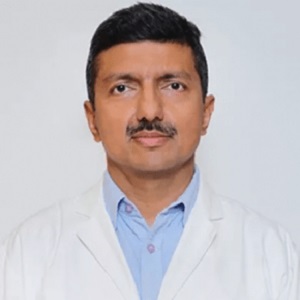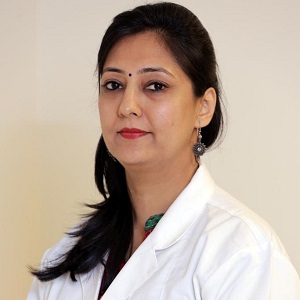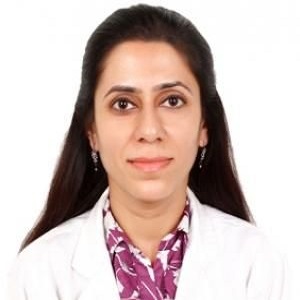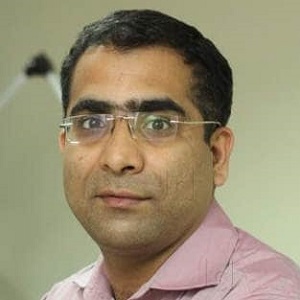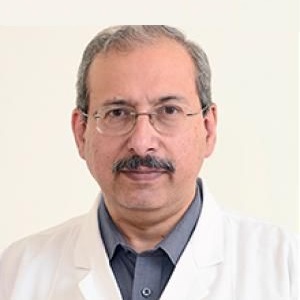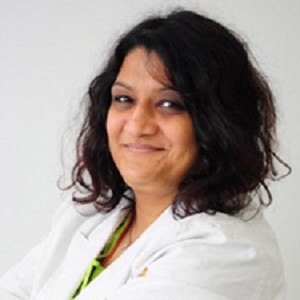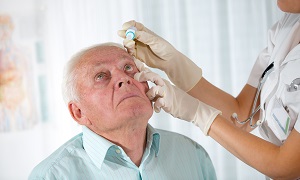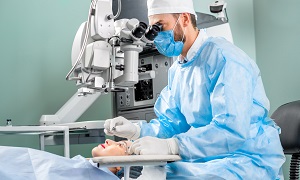Best Doctors in India for Cataracts treatment
- Eye Surgeon, Ophthalmologist, Gurugram, India
- Over 30 years’ experience
Profile Highlights:
- Dr. Sanjay Dhawan is one of the best ophthalmologists in Gurugram. In 1998 he was appointed as Assistant Professor of Ophthalmology at Manipal College of Medical Sciences, Nepal, and associated Himalaya Eye Hospital, a project of FECH of The Netherlands.
- Dr. Dhawan was also among the first to popularize the technique of SICS for mass application in New Delhi, and he probably was also the first to introduce a modified Topical Anesthesia to perform SICS. The large-scale surgical experience helped him refine the surgeries of Phacoemulsification, MICS (Phakonit), LASIK, Supra-Whitnall’s Resection of LPS for Ptosis, etc.
- Ophthalmologist, New Delhi, India
- Over 20 years’ experience
Profile Highlights:
- Dr. Deepali Garg Mathur is a Consultant Ophthalmologist who has completed her DNB from the National Board of Examination & MNAMS from the National Board of Examination.
- Dr. Deepali Garg has expertise in Squint, Paediatric Ophthalmology, cataracts, Lasik, Lasers, Eye Surgery, Corneal, Phacoemulsification, Eyesight problems, Glaucoma, Dry Eyes, Eye Pain, etc.
- Eye Surgeon, Ophthalmologist, New Delhi, India
- Over 30 years’ experience
Profile Highlights:
- Dr. Sonika Gupta is a practicing ophthalmologist with around 30 years of experience. She pursued her MBBS and MS from Aligarh Muslim University.
- Dr. Sonika Gupta is also adept at performing various eye surgeries including Cataract surgery by PHACO, Micro PHACO, LASIK Laser, PRK, Cornea transplants, C3R, other cornea, and anterior segment surgeries and lasers.
- She had undergone Observership and advanced course in PHACO, Corneal diseases, Eye Banking, and LASIK at Cornea & Laser Eye Institute, Tea Neck, New Jersey, USA
- Eye Surgeon, Ophthalmologist, New Delhi, India
- Over 36 years’ experience
Profile Highlights:
- With over 36 years of experience, Dr. Ranjana Mithal is currently practicing at Indraprastha Hospitals in Delhi. Her expertise lies in providing services for diabetic eye ailments, laser eye surgeries, glaucoma treatment as well as phaco-surgery.
- She has also gained additional specialization in LASIK & Neuro-ophthalmology.
- Dr. Ranjana Mithal is a member of several associations as well, such as the Glaucoma Society of India, and the Cataract & Refractive Society of India.
- Ophthalmologist, Eye Surgeon, Gurugram, India
- Over 20 years’ experience
Profile Highlights:
- Dr. Naginder Vashisht underwent observership in Vitreo-retina and ocular trauma under the guidance of Dr. Robert Morris, MD at Retina Specialist of Alabama, USA. Furthermore, he obtained his fellowships from the International Council of Ophthalmology (London) and the Royal College of Physicians and Surgeons of Glasgow.
- Dr. Vashisht’s area of interest in Ophthalmology includes Phacoemulsification, Uvea, Vitreo-retina, and Ocular trauma, and he also has numerous complex and advanced retinal surgeries to his credit. His specialization is in the management of diabetic eye conditions, eye trauma, and retinopathy of prematurity.
- Ophthalmologist, New Delhi, India
- Over 29 years’ experience
Profile Highlights:
- With over 29 years of experience, Dr. Tarun Kapur is one of the most renowned ophthalmologists/eye surgeons based in Delhi.
- Some of the services provided by Dr. Kapur include Avastin Injections, Glaucoma Evaluation / Treatment, Retina Examination, and keratoplasty.
- Dr. Tarun Kapur had also been awarded the National Talent Search Scholarship as well as Junior Science Talent Scholarship.
- Ophthalmologist, Gurugram, India
- Over 15 years’ experience
Profile Highlights:
- Dr. Nidhi Verma is known as one of the best ophthalmologists in Gurugram.
- Her last overseas assignment was as a Consultant at Victoria Hospital Seychelles. Her main fields of interest are Medical Retina, Glaucoma, and Uvea.
- She has also been involved in teaching undergraduate as well as postgraduate students. At Medanta Dr. Nidhi Verma is mainly involved in Preventive Health check-ups and comprehensive Ophthalmology.
- Ophthalmologist, New Delhi, India
- Over 23 years’ experience
Profile Highlights:
- Dr. Uma Mallaiah is a well-known skilled Ophthalmologist and General Physician with 23 years of clinical experience.
- Having attained her educational qualifications from renowned national and international medical institutions, she holds expertise in a number of procedures including Glaucoma treatment, Ectropion, Entropion, LASIK surgery, Phacoemulsification Surgery (MICS), Refractive Surgery as well as Evisceration with Orbital Implant.
- Throughout her career, Dr. Mallaiah is credited with successfully performing 3500 cataract surgeries and 500 glaucoma surgeries. She has also worked with Apollo to set up an Eye Department in Dubai.
- Apart from this, Dr. Uma Mallaiah has also been involved in corporate and international marketing along with organizing camps at the American embassy, Hero Honda, and Indian Oil Corporation.
- Eye Surgeon, Ophthalmologist, New Delhi, India
- Over 20 years’ experience
Profile Highlights:
- Dr. Nikhil Pal did a vitreoretinal fellowship from the University of Wisconsin, Madison, USA.
- As a Senior resident, Dr. Nikhil Pal has independently performed various basic as well as advanced Vitreoretinal surgeries including retinal detachment, vitreous hemorrhage, macular hole, dropped nucleus removal, and gained expertise in medical retina involving Fluorescein angiography/Lasers for diabetic retinopathy, ARMD, vasculitis, ROP and Phacoemulsification cataract surgery among others.
- Ophthalmologist, Gurugram, India
- Over 21 years’ experience
Profile Highlights:
- Dr. Vishakha Kapoor is a renowned ophthalmologist at Medanta Hospital, Gurugram, having over 21 years of experience.
- She provides medical Treatment for Red Eyes, Treatment of Dark circles, Treatment of Eye Pain, Treatment of the Black eye, Eye Itching, Treatment of Conjunctivitis, Weak Eyes, Eye Infection, Tearing Eyes, and Eye Burning.
- Currently, she is also a member of the Delhi Ophthalmological Society.
Best Hospitals in India for Cataracts treatment
Rela Hospital, Chennai
- City: Chennai, India
Hospital Highlights:
- RIMC is a multi-specialty hospital in a sprawling area of 36 acres located in Chromepet, Chennai, Tamil Nadu, India.
- The facility has 450 beds including 130 critical care beds, 9 operating rooms, modern reference laboratories and radiology services, and is conveniently located near road, rail and air transportation.
- RIMC is led and managed by world-renowned physicians committed to healthcare.
- RIMC offers the broadest range of clinical care, education, and research. The hospital offers state-of-the-art technology and modern treatment facilities designed to provide health care at an affordable cost.
- Rela Institute is driven by patient needs, comfort and confidence.
CARE Hospitals, Hyderabad
- City: Hyderabad, India
Hospital Highlights:
- CARE Hospitals were established in the year 2000, by CARE Group.
- The multispecialty hospital has 435 beds, including 120 critical care beds, with an annual inflow of 180000 outpatients and 16,000 in-patients.
- The hospital provides specialty medical services in Cardiology, Cardiothoracic Surgery, Pediatric Cardiology, Pediatric Cardiothoracic Surgery, Neurology, Neurosurgery, Nephrology, and Urology.
- The hospital has the first dual source, 128 slice CT scanner (for high precision cardiac imaging) – the first of its kind in south India.
- The hospital offers a wide range of accommodation facilities for the convenience of its varied patient base, ranging from general wards to super deluxe rooms.
Fortis Hiranandani Hospital, Mumbai
- City: Mumbai, India
Hospital Highlights:
- Fortis Hiranandani hospital was established in 2007.
- The hospital is an advanced tertiary care, multi-specialty hospital equipped with 149 beds.
- The hospital is equipped with a super ICU to provide emergency medical care to critically ill patients.
- The hospital is NABH accredited.
- The critical care facility in the hospital is augmented with the state-of-the-art facilities that facilitate speedier diagnosis and efficient monitoring.
- The hospital provides specialty medical services in cardiology, orthopedic science, pediatric science, neurology, diabetic care, urology, nephrology, ENT, obstetrics, gynecology, cosmetic surgery, bariatric surgery, neuro and spine care.
Fortis Hospital, Anandpur, Kolkata
- City: Kolkata, India
Hospital Highlights:
- Fortis Hospital, Anandapur, Kolkata is a world-class super-speciality equipped with the latest technologies in the medical world.
- The hospital is NABH accredited.
- This state-of-the-art facility specializes in cardiology and cardiac surgery, urology, nephrology, neurosciences, orthopaedics, digestive care, emergency care and critical care.
- The hospital, governed by integrated Building Management System (IBMS), has a pneumatic chute system, for quick vertical and horizontal transportation between floors, facilitating speedy transfer of patient specimens, documents, reports, and medicines to the concerned departments.
- The hospital also has a nephrology department with over 28 advanced dialysis units.
Gleneagles Global Hospital, Parel, Mumbai
- City: Mumbai, India
Hospital Highlights:
- Gleneagles Global Hospital The 450-bed facility comprises of 17-stories, housing state-of-the-art infrastructure, and advanced medical care facilities.
- The hospital offers end-to-end clinical, surgical, and diagnostic services. It is equipped with a team of eminent medical professionals aided by qualified nurses and medical staff
- The Hospital offers advanced Endoscopic procedures, Hepatobiliary and Liver Surgeries, Surgical and Medical Gastroenterology, Bariatric Surgery, and Robotic surgery.
- The hospital is a center of excellence for Orthopedics, Joint Replacement, Knee Replacement, and Hip Replacement surgery.
Jaypee Hospital, Noida
- City: Noida, India
Hospital Highlights:
- Jaypee Hospital is the flagship hospital of the Jaypee Group.
- This hospital has commissioned 525 beds in the first phase and has been planned and designed as a 1200 bedded multi-specialty facility.
- It holds the accreditation of the NABH and NABL.
- The hospital has state-of-the-art infrastructure equipped with the latest technologies and modern equipment like 64 Slice PET CT, Dual Head 6 Slice SPECT CT, Gamma Camera, and Da Vinci Robotic Surgery for comprehensive robotic surgical solutions.
- It has special Centers dedicated to the major specialties to provide hassle-free and high-quality clinical care.
Manipal Hospital, Dwarka, Delhi
- City: New Delhi, India
Hospital Highlights:
- Manipal Hospitals, Dwarka, is a super-specialty hospital in Dwarka, New Delhi, which is a part of Manipal Hospitals Group.
- The hospital aims to provide the best treatment on par with international standards at a fraction of the cost.
- Equipped with 380 beds, the hospital is also one of the new age hospitals which are equipped fully with state-of-the-art infrastructure, cutting-edge technology as well as the latest and advanced clinical practices. The hospital also has 13 modular Operation theatres with 118 beds which are solely meant for critical care.
- The hospital comprises internationally acclaimed doctors and highly professional and experienced hospital and medical staff who are able to provide preventive, therapeutic, and diagnostic services all under one roof.
Paras Hospital, Gurugram
- City: Gurugram, India
Hospital Highlights:
- Paras hospital was established in 2006 and is the 250 bedded flagship hospital of Paras Healthcare.
- The is supported by a team of doctors of international and national repute.
- The hospital is NABH accredited and also the first hospital in the region to have a NABL accredited laboratory.
- The hospital provides specialty medical services in around 55 departments including Neurosciences, Joint Replacement, Mother & Child Care, Minimal Invasive Surgery, Gynecology and Obstetrics, Ophthalmology, Dermatology, Endocrinology, Rheumatology, Cosmetic and Plastic surgery.
- The hospital is equipped with state-of-the-art technologies.
S L Raheja Hospital, Mahim, Mumbai
- City: Mumbai, India
Hospital Highlights:
- SL Raheja hospital is a 140-bed multi-specialty tertiary care hospital that is being managed by Fortis Healthcare Ltd.
- The hospital is a benchmark in healthcare and medical facilities in the neighborhood of Mahim & the western suburbs.
- L.Raheja Hospital, Mahim has one of the most effective ICU and Casualty care services.
- The hospital provides specialty medical services in Cardiology, Oncology, Neurology, Orthopedics, Mother & Child Care, and in Diabetes.
Wockhardt Hospitals, Mumbai
- City: Mumbai, India
Hospital Highlights:
- Wockhardt Hospitals were established in the year 1973, originally called First Hospitals and Heart Institute.
- Wockhardt Hospitals are super specialty health care networks in India, nurtured by Wockhardt Ltd, India’s 5th largest Pharmaceutical and Healthcare company.
- Wockhardt Hospitals is associated with Partners Harvard Medical International, an international arm of Harvard Medical School, USA.
- Wockhardt Heart Hospital performed India’s first endoscopic heart surgery.
- The hospital has a state-of-the-art infrastructure equipped with the latest technologies and modern equipment.
- It has special Centers of Excellence dedicated to the major specialties to provide hassle-free and high-quality clinical care.
Cataracts
When a clouding is formed over the clear lens of the eyes, it is called a Cataract. People suffering from this ailment feel like seeing through a frosty or fogged-up window when they see through their cloudy lenses. It causes difficulty in several day-to-day activities, such as reading, driving or even seeing somebody’s face clearly.
Although most cataracts develop slowly, your eyesight doesn’t get disturbed early on. However, over time, it eventually starts interfering with your vision. Sometimes cataracts also make the colors appear less vibrant and yellowed, similar to a sepia-toned photo. Though it is known as the most common cause of vision loss worldwide, it is treatable.
Initially, stronger lighting and eyeglass can help people who are suffering from cataracts. However, if it continues to interfere with daily activities, cataract surgery might be the best option. Cataract surgery is generally safe as well as effective.
Cataracts usually result when people get older, and usually after the age of forty. This happens as the proteins that make up the lens start to clump together, causing the clouding.
Symptoms of Cataracts
The signs and symptoms of cataracts can include:
- Clouded, dim or blurred vision
- Difficulty in vision, especially at night
- Light sensitivity
- Visual halos around bright lights
- Double vision
- Requiring brighter light for reading or any such activity.
An outside viewer will see that the pupil of the cataract patient will appear light gray rather than black when it reaches an advanced stage.
Common types of Cataracts
There are different types of Cataracts:
- Nuclear cataracts- A nuclear cataract forms in the center of the lens of the eyes, and usually causes nearsightedness or even an improvement in one’s reading vision, temporarily. However, over time, it gradually worsens and affects the vision, turning it densely yellow, and further clouding it.
- Cortical Cataracts- A cortical cataract is a type of cataract that affects the edges of the lens. It begins as a whitish, wedge-shaped opacities or streaks on the lens cortex’s outer edge. When it slowly progresses, the streaks extend to the center which causes interference with the light that passes through the center of the lens.
- Posterior subcapsular cataracts- This kind of cataract develops along the back of the lens, and unfortunately, compared to the others, it develops much more quickly. It can interfere with your reading vision, reduce your vision in bright light, and also cause halos around lights at night.
- Congenital cataracts- Some people have cataracts since birth, or develop them in early childhood. This kind of cataracts can be genetic, or even associated with an intrauterine infection or trauma.
Causes of Cataracts
Most Cataracts develop due to aging, or when an injury changes the tissue that makes up the eye lens. Sometimes inherited genetic disorders that cause health problems can also increase one’s risk of cataracts. Medical conditions such as diabetes, or past eye surgery can also sometimes contribute to cataracts. Using steroid medications for a long time can also cause it to develop.
How Cataracts form:
The lens, where the cataracts form, is positioned behind the iris, the colored part of the eye. The lens focuses the light which is passed into your eye, producing a clear and sharp image on the retina. However, when you age, the flexibility of your lenses decreases, and they also cause the lens to break down and clump together, which causes clouding in small areas within the lens.
As the cataract continues to develop, the clouding becomes denser and involves a bigger part of the lens during this period of time. The cataract scatters as well as blocks the light when it tries to pass through the lens, and due to this, the sharply defined image is unable to reach the retina. This causes the vision to become blurry.
Risk Factors of Cataracts
The risk factors of Cataracts are:
- Excessive UV radiation
- Smoking
- High blood pressure
- Obesity
- Excessive Alcohol Intake
- Eye Injury
- Previous Eye Surgery
- Eye Inflammation
- Family History of Cataracts.
Preventing Cataracts
There is nothing that can guarantee to stop cataracts from developing, as they simply appear as we age. However, there are still some preventive measures that we can take to limit the risk factors.
- Wearing sunglasses during the daytime can help ones’ eyes from being exposed to the sun’s UV radiation.
- Quitting smoking can also help in the prevention of cataracts.
- Eating a healthy diet is also very important, and maintaining an exercise regiment, even if it is just light physical activity such as walking.
- Managing and reducing the effects of coexisting conditions such as diabetes or hypertension can help as well.
- One can consider getting eye exams done frequently in order to ensure that if cataracts are developing, they are diagnosed quite early.
- If you have other health problems, such as diabetes, which can increase the risk of cataracts, it is important that you follow your treatment plan properly.
Diagnosis of Cataracts
When you want to determine whether you are having cataracts, your doctor will need to review your medical history and look for symptoms. An eye examination will also need to be performed. Your doctor may perform several tests, which can include the following:
Visual Acuity Test
Visual acuity test uses eye charts in order to measure how well you are able to read a series of letters. One eye is tested one at a time, while the other remains covered. With the help of the chart, the eye doctor is able to determine if you have 20/20 vision, or if the eye is showing signs of impairment.
Slit-lamp examination
Retinal exam
Surgery for Cataracts
Surgery is the only effective treatment for cataracts when the prescription glasses can no longer give you the clear vision that you want.
First, you need to consult with your eye doctor, whether surgery is right for you. Eye doctors usually suggest surgery only when one’s quality of life is affected and you are unable to perform your day-to-day activities.
However, the decision remains up to you once the doctor has made the decision. Most people don’t rush to remove their cataracts as, despite the difficulties, it doesn’t really harm their eyes. However, it is important to note that for people with diabetes, cataracts can worsen quite fast.
The surgery is done on an outpatient basis, which means that you are able to go home right after the surgery. The surgery involves the surgeon removing your natural lens and replacing it with an artificial one. It has a high success rate, and 96 percent of people claim that they see better afterwards.
If you delay the procedure, it won’t affect much how well your vision recovers if you later make the decision to go through cataract surgery. Take time to consider the benefits as well as the risks of the surgery with your specialist.

